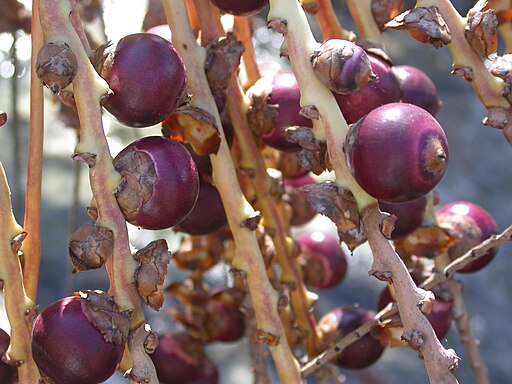I was just fascinated by this astonishing cold hardy palm. Trachycarpus fortunei, native to the high mountains of India, Burma and China, near the Himalaians, is not only cold hardy to -20ºC (zone 6 or 7), but also grows well in climates with cold and rainy summers, such as the UK. It has even been experimented in the Faroe Islands and Alaska, and with success!
Therefore, I very much want to try to grow it also here in Iceland, which is only slightly more north. The freezes here are more dramatic and very long, but the idea of having a palm growing in this polar island is very appealing and exotic! This palm is very hardy to cold, but not to wind, so one must find a sheltered spot for it.
Another idea that also interests me, is growing hardy coconuts. Of course not in Iceland, but in Portugal. So far I haven't heard of any coconut grown in Europe, but I believe it is possible.
Not the conventional coconut (Cocos nucifera), which requires tropical climates (could be tried in zone 10), but other species that also produce edible coconuts. Beccariophoenix alfredii (hardy to perhaps zone 9) can stand a few degrees of frost but it will die during a hard freeze (or be permanently damaged). Beccariophoenix madagascariensis is very similar and grows in the high plateau of Madagascar, where temperatures drop ocasionally below freezing. I guess these coconuts could be grown in coastal and south regions of Portugal, Spain, Italy, California and Florida.
There are two varieties (or even different species): Parajubaea torallyi var. microcarpa produces coconut-like fruits but smaller than a walnut (www.rarepalmseeds.comwww.rarepalmseeds.com). Parajubaea torallyi var. torallyi produces much larger coconut-like fruits (around 10cm and 15 kg), but it is much more expensive and difficult to find (sources include http://www.cycadpalm.com/patobomocopa.htm, http://www.paradise-palms.co.uk/parajubaea-torallyi-torallyi-p-445.html and possibly http://www.mulu.co.uk/plant_info.php?id=1099 and sometimes in ebay). Parajubaea sunkha, is another species endemic to Bolivia, and also endangered, and probably similarly cold hardy. Apparently, these coconuts are erratic in germination and sensitive to transplantation.
In a future article I will explore date palms, banana trees and enset, other cultivated edible palms.
Therefore, I very much want to try to grow it also here in Iceland, which is only slightly more north. The freezes here are more dramatic and very long, but the idea of having a palm growing in this polar island is very appealing and exotic! This palm is very hardy to cold, but not to wind, so one must find a sheltered spot for it.
 |
| Trachycarpus fortunei, the hardiest of all palms, ideal for cold climates |
Another idea that also interests me, is growing hardy coconuts. Of course not in Iceland, but in Portugal. So far I haven't heard of any coconut grown in Europe, but I believe it is possible.
Not the conventional coconut (Cocos nucifera), which requires tropical climates (could be tried in zone 10), but other species that also produce edible coconuts. Beccariophoenix alfredii (hardy to perhaps zone 9) can stand a few degrees of frost but it will die during a hard freeze (or be permanently damaged). Beccariophoenix madagascariensis is very similar and grows in the high plateau of Madagascar, where temperatures drop ocasionally below freezing. I guess these coconuts could be grown in coastal and south regions of Portugal, Spain, Italy, California and Florida.
 |
| Beccariophoenix alfredii produces small coconut like fruits, possibly hardy to zone 9 |
Perhaps the best choice are Parajubaea species, the Bolivian Mountain Coconut. Parajubaea torallyi is native to the high mountains of Bolivia, and can survive down to -8ºC (but probably only if for short periods). It could be tried in Mediterranean climates, where frosts are gentle. This species is also an endangered species, because it seems to be very specific to its habitat. It grows in steep rock slopes, that are very humid, but the surrounding climate is very dry and sheltered from winds. On its native region it can stand extremes of both heat and cold (even down to -13ºC), but many trials to grow it outside its native habitat have failed. Probably it needs dry soil when frosts come, and they are probably for short hours, only to be followed by sunny warm afternoons. The summer temperatures are also rather cool (around 20ºC). In Europe this palm has had some success in coastal area of UK and Italy, but it can die below -5ºC. Coastal Portugal and Spain might be an even better location for it.
| The Bolivian Mountain Coconut is a hardy species but also endangered. Some varieties produce large coconuts, and could probably be grown in Mediterranean climates. |
There are two varieties (or even different species): Parajubaea torallyi var. microcarpa produces coconut-like fruits but smaller than a walnut (www.rarepalmseeds.comwww.rarepalmseeds.com). Parajubaea torallyi var. torallyi produces much larger coconut-like fruits (around 10cm and 15 kg), but it is much more expensive and difficult to find (sources include http://www.cycadpalm.com/patobomocopa.htm, http://www.paradise-palms.co.uk/parajubaea-torallyi-torallyi-p-445.html and possibly http://www.mulu.co.uk/plant_info.php?id=1099 and sometimes in ebay). Parajubaea sunkha, is another species endemic to Bolivia, and also endangered, and probably similarly cold hardy. Apparently, these coconuts are erratic in germination and sensitive to transplantation.
 |
| The fruits of the Bolivian Mountain Coconut, an endangered but edible coconut, that is cold hardy. |
In a future article I will explore date palms, banana trees and enset, other cultivated edible palms.

No comments:
Post a Comment